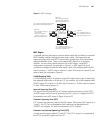
Configuring MSTP 255
Configuring the Time
Parameters of a Switch
The switch has three time parameters:
■ forward delay,
■ hello time,
■ and max age.
Forward delay is the switch state transition mechanism. The spanning tree will be
recalculated upon link faults and its structure will change accordingly. The
configuration BPDU recalculated cannot be immediately propagated throughout
the network. Temporary loops can occur if the new root port and designated port
forward data, right after being elected. Therefore, the protocol adopts a state
transition mechanism. It takes a forward delay interval for the root port and
designated port to transit from the learning state to forwarding state. The forward
delay guarantees a period of time during which the new configuration BPDU can
be propagated throughout the network.
The switch sends a hello packet periodically to check if there is any link fault. The
interval in which the hello packet is sent is specified by the hello timer.
Max age specifies when the configuration BPDU expires. The switch will discard
the expired configuration BPDU.
You can use the following command to configure the time parameters for the
switch.
Perform the following configuration in system view.
Every switch on the switching network adopts the values of the time parameters
configured on the root switch of the CIST.
The forward delay configured on a switch depends on the switching network
diameter. Generally, the forward delay is supposed to be longer when the network
diameter is longer. Note that a forward delay that is too short can redistribute
some redundant routes temporarily, while a forward delay that is too long can
prolong the network connection resuming. The default value is recommended.
A suitable hello time ensures that the switch can detect the link fault on the
network, but also occupy moderate network resources. The default value is
recommended. If you set a hello time that is too long, when there is packet
dropped over a link, the switch may consider it as link fault and the network
device will recalculate the spanning tree accordingly. However, for a hello time
that is too short, the switch frequently sends configuration BPDU, which adds
burden and wastes the network resources.
Table 9 Configure the Time Parameters of a Switch
Operation Command
Configure Forward Delay on the switch. stp timer forward-delay centiseconds
Restore the default Forward Delay of the
switch.
undo stp timer forward-delay
Configure Hello Time on the switch. stp timer hello centiseconds
Restore the default Hello Time on the switch. undo stp timer hello
Configure Max Age on the switch. stp timer max-age centiseconds
Restore the default Max Age on the switch. undo stp timer max-age


















